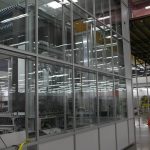 Building or retrofitting an operation to be environmentally friendly is not a new idea, but it is an increasingly popular one. On top of numerous benefits, executives feel it is both the “right thing” and expected by clients. However, with cleanrooms, there are many people who decide not to go green. Here we will outline some things to consider for your own facility.
Building or retrofitting an operation to be environmentally friendly is not a new idea, but it is an increasingly popular one. On top of numerous benefits, executives feel it is both the “right thing” and expected by clients. However, with cleanrooms, there are many people who decide not to go green. Here we will outline some things to consider for your own facility.
Leadership in Energy and Environmental Design (LEED)
Leadership in Energy and Environmental Design (LEED) is the most widely used green building certification program in the world. It is a voluntary program providing third-party certification of green buildings through the US Green Building Council (USGBC). It’s a certification process for materials, methods of construction, operation, and also maintenance.
There are, however, alternatives. Green Globes touts its program as “interactive, flexible, and affordable, and providing market recognition of a building’s environmental attributes through third-party verification.” ENERGY STAR is a U.S. government initiative. If you are building or remodeling outside of the U.S., you have other options to research as well.
Benefits of a Green Cleanroom
The benefits of going green – whether building from scratch or retrofitting – are many. Among the most significant are:
- Improvements to the bottom line
- Reduced operating costs
- Reduced energy costs
- Reduced water consumption
McGraw-Hill Construction (MHC)’s 2013 Dodge Construction Green Outlook reported that new green building projects saved a median of 8% over one year and 15% over five years. Building values increased by 7%. Green retrofits experienced higher savings in operating costs, decreasing 9% over one year and 13% over five years. Asset valuations increased more modestly, however, at about 5%.
Payback on green efforts is expected within eight years for new projects and seven years for renovations. However, a case study in the MHC report took only two years.
Downsides of a Green Cleanroom
There are a number of reasons that companies do not seek green certification. Among them are:
- Cost of the certification process
- Staff time required
- Time required for the process
- Overall (perceived) difficulty of the process
Ultimately, the decision will be different for each company. Looking at all the certification options, one may be more appealing than the others. For example, if energy efficiency is a priority, the ENERGY STAR certification may be the most relevant option to weigh.
Key Questions:
Richard Bilodeau, PE in his Controlled Environments article, “To LEED or not to LEED?” offered ten key questions to answer when making this decision:
-
- • What’s the expected cost? The expected timeline?
- • Do you have the staff to manage and see the certification process through?
- • Do you anticipate disposing of the property or the business in the near future? As part of an acquisition or outright sale? Or do you anticipate retaining the asset? Is there a value to the certification in any of these scenarios?
- • How important to your company is the “brand value” of a third-party certification?
- • How much value would a third party certification hold for your clients or customers? For your investors? For your employees?
- • Are you a publicly traded company with significant expectations for your Corporate Social Responsibility (CSR) program?
- • Will the certification process assist in guiding the choices you must make during a building design and construction program?
- • How does the “C-suite” weigh in? How does your Investor Relations department feel? Legal? Corporate Communications? Human Resources?
- • If you pursue and obtain certification, what’s your plan to maximize its value to your business post-award?
With these points in mind, you will be able to make a more informed, competent decision about going green.
For questions regarding the cleanroom industry, contact us at 888-628-0056 or info@gerbig.com.